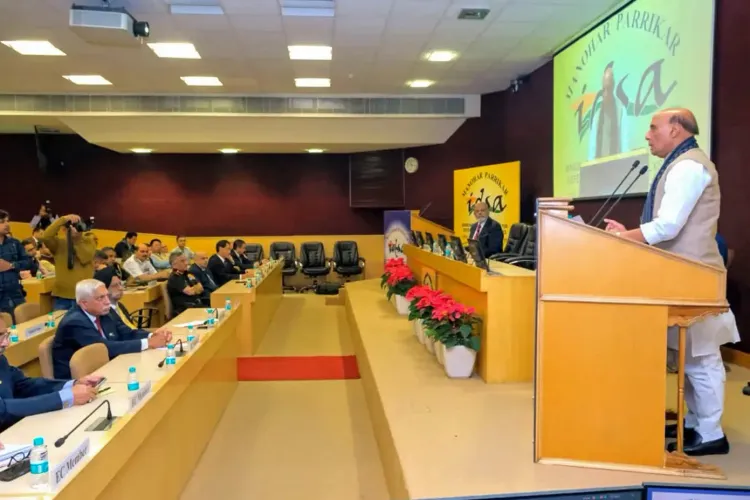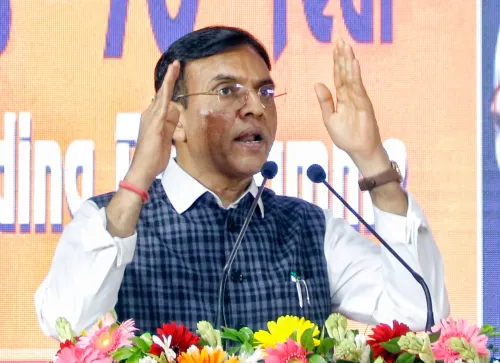How Can Soldiers, Scientists, and Startups Collaborate for Innovative Defence Technology?

Synopsis
Key Takeaways
- Collaboration among soldiers, scientists, and startups is crucial for defence innovation.
- India aims to transition from technology consumers to creators.
- Initiatives like iDEX and TDF are essential for nurturing innovators.
- Digital sovereignty is vital for strategic autonomy.
- Ethical considerations in technology use are imperative.
New Delhi, Nov 11 (NationPress) Emphasizing the government's mission to position India as a technological frontrunner, Defence Minister Rajnath Singh stated on Tuesday that the nation's defence industrial framework is undergoing rapid expansion, fueled by the collaboration among DRDO, Armed Forces, industry, and academia. This synergy is establishing a positive feedback loop of research, testing, field feedback, and innovation.
While addressing the inaugural session at the Delhi Defence Dialogue, hosted by the Manohar Parrikar Institute for Defence Studies and Analyses (MP-IDSA), he focused on the theme of ‘Harnessing New Age Technology for Defence Capability Development.’
The Minister asserted that for India to transition from being a consumer to a creator of technology, it is crucial to not only adopt new innovations but to cultivate an environment where niche products can flourish through efficient processes, agile institutions, and a collaborative spirit that brings together the soldier, scientist, startup, and strategist.
Rajnath Singh pointed out that India must no longer be satisfied with merely catching up to global innovations. The country needs to continue fostering a culture of innovation by promoting collaboration over isolation, and speed over bureaucratic delays.
He highlighted initiatives like Innovations for Defence Excellence (iDEX) and the Technology Development Fund (TDF) that are nurturing a new generation of innovators. “These individuals are the architects of a future where advanced technologies such as autonomous systems, quantum sensors, and space-based surveillance will reflect Indian creativity,” he noted, emphasizing the collective effort toward the mission of Viksit Bharat and Aatmanirbharta.
Rajnath Singh stressed the importance of extending Aatmanirbharta beyond just manufacturing indigenous systems to achieving digital sovereignty, which means having control over algorithms, data, and chips essential for operational platforms. “True strategic autonomy will manifest only when our code is as homegrown as our hardware. We are, therefore, promoting secure, indigenous software frameworks, reliable semiconductor supply chains, and AI models developed on Indian data,” he stated.
“While we are excited about machines and algorithms, it is vital to remember that technology should not replace human judgement but enhance it. We must also invest in the ethical, psychological, and legal aspects of these emerging technologies. As a civilizational power, India must lead the dialogue on the responsible and humane application of military technology,” he added.
The Minister affirmed that technology should be viewed not only as a force multiplier but also as a resource optimizer. He advocated for utilizing technology and data analytics in the capital procurement process to enhance decision-making and ensure optimal resource utilization. “In many advanced nations, the life-cycle cost concept is intricately woven into their procurement frameworks. I have recently directed that we, too, need to evaluate these sustainment costs right from the inception of every procurement proposal. This will help us understand the entire picture—what we invest today and what we need to sustain tomorrow,” he explained.
He encouraged the Armed Forces to stay vigilant for best global practices not just in equipment technology but also in training, logistics, planning, and management systems.
While emphasizing the need to absorb and adapt to disruptive technologies such as Artificial Intelligence (AI), Machine Learning, Quantum Computing, and Swarm Tech, he remarked that the true measure of progress lies in the functionality of the apparatus.
“Embracing technology is not merely about incorporating new tools; it is about making our institutions more agile, anticipatory, and adaptive, and constructing a defence architecture that learns continuously, reacts instantly, and evolves ceaselessly in line with the pace of change,” he concluded.
Chief of Defence Staff General Anil Chauhan, Ambassadors from allied nations, and various civil and military officials were present at the event.









